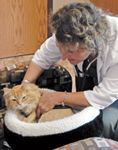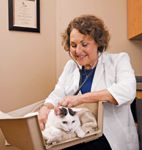Leading Off: Do you see cats? Then you need these environmental guidelines
The guidelines address the benefits to meeting cats' environmental needs and understanding cats and their species-specific needs.
Do you enjoy working with inappropriate elimination? What about difficult-to-control feline idiopathic or interstitial cystitis (lower urinary tract disease)? How about the challenges of introducing a new cat into a multicat household?

Dr. Rodan examines Cheetos in a basket in a chair to help the cat feel more comfortable.
If you answered "No" to any of the above questions, the 2013 AAFP and ISFM Feline Environmental Needs Guidelines, produced by the American Association of Feline Practitioners and the International Society of Feline Medicine, are for you. (Download a PDF at catvets.com/professionals/guidelines/publications/?Id=487.)
What you'll find
Although cats are beloved family members to most people, we inadvertently do not provide for cats' needs because of a lack of understanding of these needs, which differ vastly from our own. Meeting the environmental needs of cats is not optional, but rather essential to the physical and emotional health of our feline patients.

Dr. Rodan examines another cat while it rests comfortably in the bottom half of its carrier.
The guidelines address the benefits to meeting cats' environmental needs and understanding cats and their species-specific needs. It also addresses the five pillars of a healthy feline environment. It is essential to meet cats' needs and allow them to express their natural behaviors, to prevent stress and undesirable behavior, and to improve feline health and welfare. The recommendations in the guidelines apply to all pet cats, regardless of lifestyle (indoor vs. indoor/outdoor) and location (home, veterinary practice, or shelter).
My view
As a veterinary practitioner, I find these guidelines to be the support that many of us practitioners need to help prevent and even resolve many behavior problems. If we understand cats and their needs and educate our veterinary teams and clients about how to live with these beloved pets, we can keep cats healthier and happier—and ensure cat owners enjoy their beloved cats.

About the panel members
Incorporating these guidelines into your practice and client education can help prevent or reduce behavior problems and stress-associated illness and enhance the relationship that cat lovers have with their cats and with your practice.
Ilona Rodan, DVM, DABVP (feline practice)
Cat Care Clinic Behavior Consultations for Cats
322 Junction Road
Madison, WI 53717








